Dia del Mercado, Zumbahua, Ecuador
Stepping off the bus with our bulky packs, a local woman pointed to us and shouted “Gringos! Gringos!” We were the only ones that day, though not a rare sight, and a man with a pickup ran right up to us to offer his bouncy ride to the Laguna Quilotoa, a lake in a big, round crater. It was a particularly foggy morning in Zumbahua, a little village in the green checkered farmed hillsides just south of Quito, we’d been in buses for 12 hours, and we were crabby. With little time left to spend in Ecuador, we had to chose our destinations with care and we’d come to this place because the guide book said it was “awe-inspiring” and “the best circuit to hike in all of Ecuador.” But there in the fog the hilltops were hidden, the volcanoes nonexistent, the air cold, and the locals pushy. Thank you, Lonely Planet.
We went to Quilotoa to hike the rim of the crater but it rained on us as usual, so we turned back, discouraged. I felt a little ashamed of myself to think of a big lake in a crater as so-so, but it just didn’t explode in my heart the way that Crater Lake did the first time I saw it.
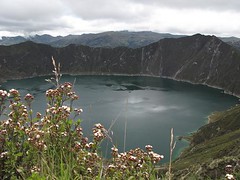
Certainly something to see if you’ve never seen a crater but we should have gone to Baños, where a mountain may soon be but a crater as it is exploding and off-gassing all the time!
The trip and the hours spent in transport were all worthwhile in the end, though, when we went to the local market of Zumbahua, not in the least a tourist affair.
The Mercado:
On a long, cluttered table, piles of carrots run into potatoes, which roll over onto the tomatoes, nestled into the lettuce. And there, in the middle of the veggies sits a little girl, maybe 2 years old, sucking on the end of a carrot while mom makes change.
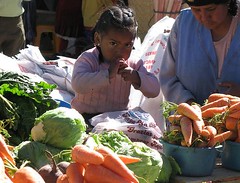
Hundreds and hundreds of bananas in all their local forms… platanos, bananas, red, brown, yellow, green, 3 inches long, and longer than a foot. They line the ground, sticking up from their stocks, making for spiky yellow walkways. Ecuador is the number one banana exporter in the world.
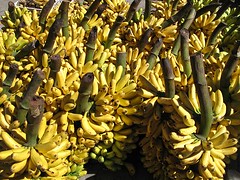
A local woman stands chatting with two men and another woman. She’s smiling, laughing. She wears dusty black leather shoes (the shoes worn by all women in the market) white socks up to the knee, a velvet skirt with glitter designs sparkling in the sun. It falls to just below the knee where the sock takes over. Around her shoulders she wears a bright almost fluorescent pink blanket/shawl with fringes around the edges and embroidered flowers in the same color. Around her neck are five or six strands of gold-colored brilliant beads. I’m not sure if they’re painted plastic or painted metal. As she talks she moves her head, on which sits a green felt European men’s-style hat like those you see in old detective films. In the ribbon above the brim, the top of a peacock feather ruffles in the wind. Most men and women wear these hats. This scene is so usual that I hardly notice she’s holding a chicken by the feet like one would hold fresh flowers or a bottle of water. She continues talking while the chicken clucks and moves its wings around, sees the world upside-down, doesn’t know of its imminent fate.
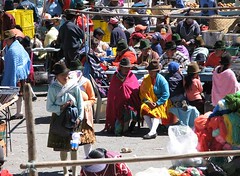
Below the market, sheep are unloaded, baaing, from the tops of buses, pigs are tied by leash to parked cars. The meat here is fresh and if you’re willing to stick around for it, you can see the throat being cut. Next to the butcher section, a girl at a stand chats with a customer while her fingers play with the fur on a body less cow head sitting on the table.
Up among the clothes, a woman dressed traditionally walks the aisles and stops to watch a dusty man in ninja clothing do a watered-down karate demonstration for a crowd of kids. Her shoes look like the shoes of all the other women… dusty black leather, worn, too small, sort of square, an inch heel, and there where the side meets the top there’s a copper-colored rivet. And on the rivet is a tiny Playboy Bunny.
On the very edge of the market, two men with foot pedal-powered sewing machines concentrate on the mending before them. The peacock feathers on their hats bow as they look down at their work.
A woman selling peppers smiles at me – a wide, sincere five tooth smile that crinkles the skin of her cheeks. I ask her if I can take a picture of her peppers and, still smiling, she says yes.
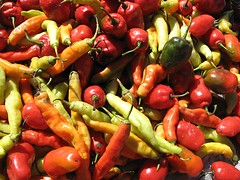
Llamas and alpacas sit on their haunches, ever the look of pride in their eyes as the cloud cover breaks and the valley turns from mild greys to color, patches of varying greens and yellows, grasses shining and rippling in the wind.
Tags: Ecuador, laguna quilotoa, Travel

May 6th, 2007 at 10:23 pm
I’m realizing that the LP is not all it’s cracked up to be, our mag is gonna be so much better and way more up to date. 9 more days until I see you, yayyyyyy!!!!
May 8th, 2007 at 9:41 pm
Quilotoa didn’t do it for you? That’s too bad. There was a really pretty hike in between there and Chugchilán. I’m not sure you would have found much cultural value in Baños. It’s fully gringo-fied.
Dunno if this link will work, but here goes:
http://cb.nfshost.com/q.jpg
May 9th, 2007 at 9:55 am
Everyone’s experience is different…
May 9th, 2007 at 9:05 pm
No they’re not. They’re all the same.
May 11th, 2007 at 2:53 pm
Yes they are.